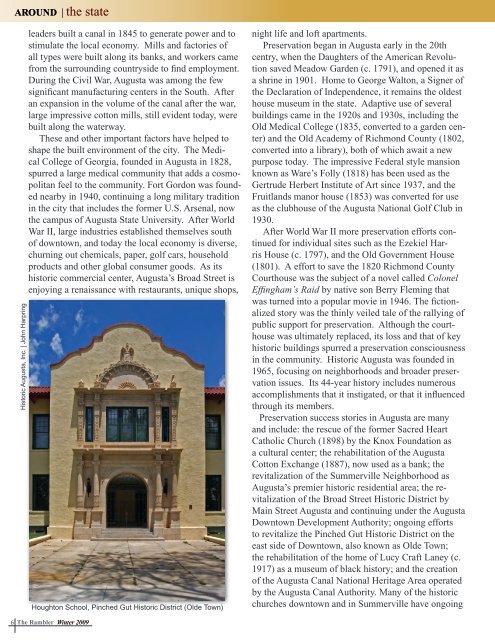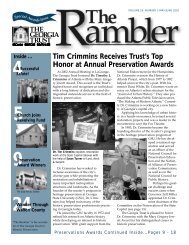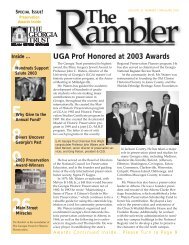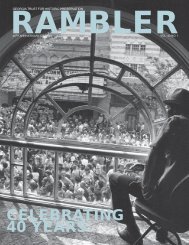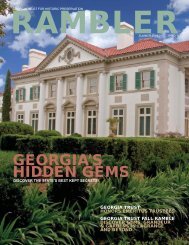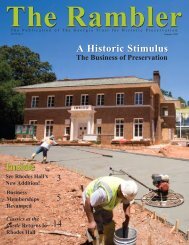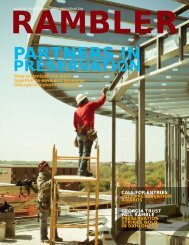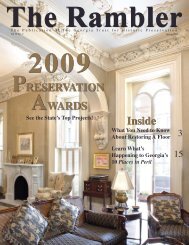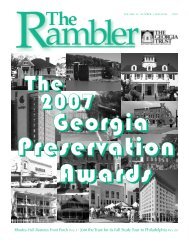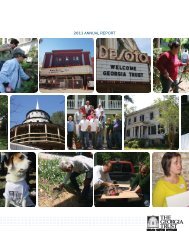Winter 2009 - The Georgia Trust for Historic Preservation
Winter 2009 - The Georgia Trust for Historic Preservation
Winter 2009 - The Georgia Trust for Historic Preservation
You also want an ePaper? Increase the reach of your titles
YUMPU automatically turns print PDFs into web optimized ePapers that Google loves.
AROUND | the state<br />
<strong>Historic</strong> Augusta, Inc. | John Harpring<br />
leaders built a canal in 1845 to generate power and to<br />
stimulate the local economy. Mills and factories of<br />
all types were built along its banks, and workers came<br />
from the surrounding countryside to find employment.<br />
During the Civil War, Augusta was among the few<br />
significant manufacturing centers in the South. After<br />
an expansion in the volume of the canal after the war,<br />
large impressive cotton mills, still evident today, were<br />
built along the waterway.<br />
<strong>The</strong>se and other important factors have helped to<br />
shape the built environment of the city. <strong>The</strong> Medical<br />
College of <strong>Georgia</strong>, founded in Augusta in 1828,<br />
spurred a large medical community that adds a cosmopolitan<br />
feel to the community. Fort Gordon was founded<br />
nearby in 1940, continuing a long military tradition<br />
in the city that includes the <strong>for</strong>mer U.S. Arsenal, now<br />
the campus of Augusta State University. After World<br />
War II, large industries established themselves south<br />
of downtown, and today the local economy is diverse,<br />
churning out chemicals, paper, golf cars, household<br />
products and other global consumer goods. As its<br />
historic commercial center, Augusta’s Broad Street is<br />
enjoying a renaissance with restaurants, unique shops,<br />
Houghton School, Pinched Gut <strong>Historic</strong> District (Olde Town)<br />
night life and loft apartments.<br />
<strong>Preservation</strong> began in Augusta early in the 20th<br />
centry, when the Daughters of the American Revolution<br />
saved Meadow Garden (c. 1791), and opened it as<br />
a shrine in 1901. Home to George Walton, a Signer of<br />
the Declaration of Independence, it remains the oldest<br />
house museum in the state. Adaptive use of several<br />
buildings came in the 1920s and 1930s, including the<br />
Old Medical College (1835, converted to a garden center)<br />
and the Old Academy of Richmond County (1802,<br />
converted into a library), both of which await a new<br />
purpose today. <strong>The</strong> impressive Federal style mansion<br />
known as Ware’s Folly (1818) has been used as the<br />
Gertrude Herbert Institute of Art since 1937, and the<br />
Fruitlands manor house (1853) was converted <strong>for</strong> use<br />
as the clubhouse of the Augusta National Golf Club in<br />
1930.<br />
After World War II more preservation ef<strong>for</strong>ts continued<br />
<strong>for</strong> individual sites such as the Ezekiel Harris<br />
House (c. 1797), and the Old Government House<br />
(1801). A ef<strong>for</strong>t to save the 1820 Richmond County<br />
Courthouse was the subject of a novel called Colonel<br />
Effingham’s Raid by native son Berry Fleming that<br />
was turned into a popular movie in 1946. <strong>The</strong> fictionalized<br />
story was the thinly veiled tale of the rallying of<br />
public support <strong>for</strong> preservation. Although the courthouse<br />
was ultimately replaced, its loss and that of key<br />
historic buildings spurred a preservation consciousness<br />
in the community. <strong>Historic</strong> Augusta was founded in<br />
1965, focusing on neighborhoods and broader preservation<br />
issues. Its 44-year history includes numerous<br />
accomplishments that it instigated, or that it influenced<br />
through its members.<br />
<strong>Preservation</strong> success stories in Augusta are many<br />
and include: the rescue of the <strong>for</strong>mer Sacred Heart<br />
Catholic Church (1898) by the Knox Foundation as<br />
a cultural center; the rehabilitation of the Augusta<br />
Cotton Exchange (1887), now used as a bank; the<br />
revitalization of the Summerville Neighborhood as<br />
Augusta’s premier historic residential area; the revitalization<br />
of the Broad Street <strong>Historic</strong> District by<br />
Main Street Augusta and continuing under the Augusta<br />
Downtown Development Authority; ongoing ef<strong>for</strong>ts<br />
to revitalize the Pinched Gut <strong>Historic</strong> District on the<br />
east side of Downtown, also known as Olde Town;<br />
the rehabilitation of the home of Lucy Craft Laney (c.<br />
1917) as a museum of black history; and the creation<br />
of the Augusta Canal National Heritage Area operated<br />
by the Augusta Canal Authority. Many of the historic<br />
churches downtown and in Summerville have ongoing<br />
6 <strong>The</strong> Rambler <strong>Winter</strong> <strong>2009</strong>


